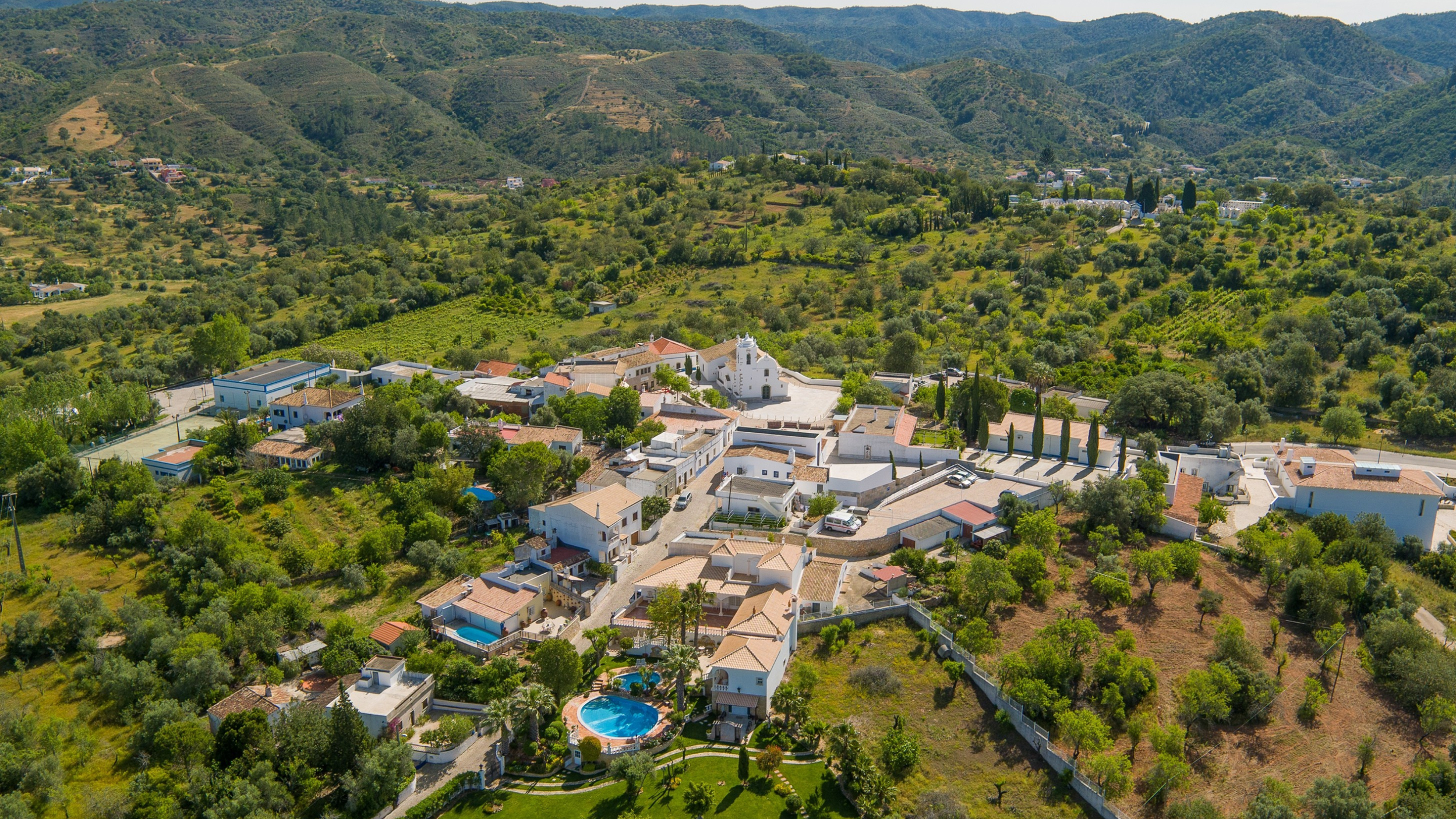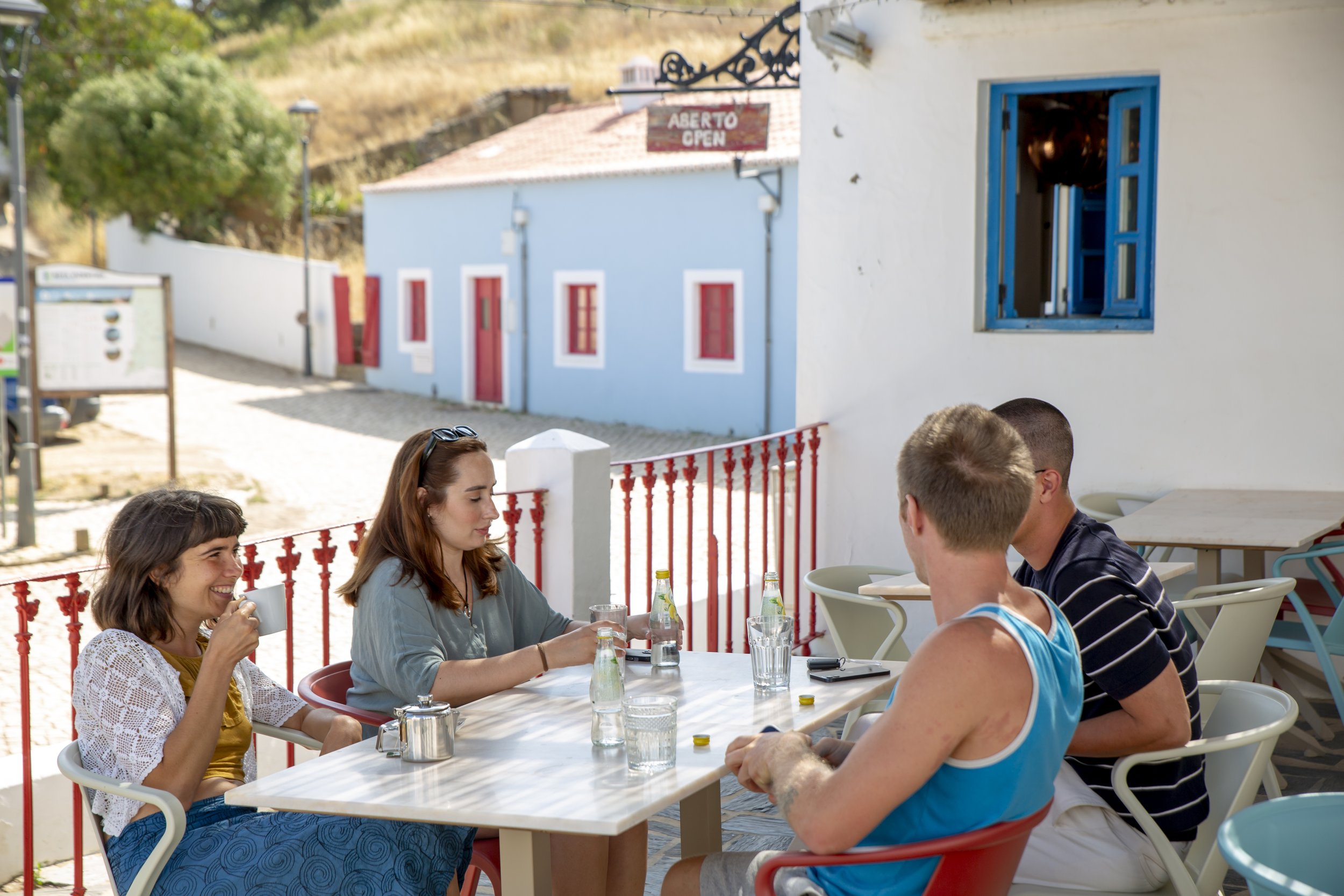Let yourself be enchanted by these villages in the Algarve
Querença
From mountain hamlets to fishing enclaves, these are some of the most charming villages in the Algarve, each offering a different glimpse into the region’s cultural heart.
Each of these villages reveals a different Algarve — one of hospitality, flavour, and timeless beauty, that invites travellers to slow down and experience the rhythm of local life.
1. Alte
Perched among the green hills of the Barrocal, Alte is frequently described as the most typical village in the Algarve. Whitewashed houses, cobbled alleys, and bougainvillea-covered walls create a postcard-perfect atmosphere.
Municipality: Loulé
Getting there: From Albufeira, take the N124 toward São Bartolomeu de Messines (around 30 minutes). Parking available near the main square.
Heritage: The 16th-century Church of Nossa Senhora da Assunção stands out for its Manueline doorway and tiled interior. Nearby, Fonte Pequena and Fonte Grande — two natural springs — have been gathering places for locals for centuries.
Festivities & Traditions: During Easter, Alte’s streets fill with processions and flower carpets. In April, the Festival de Alte celebrates crafts, poetry, and music inspired by local poet Cândido Guerreiro.
Gastronomy: Don’t miss Dom Rodrigo (a sweet made from egg yolks and almonds) and local honey.
Curiosities: Alte inspired several 20th-century poets, and you can follow a Poets’ Trail featuring verses engraved along its alleys.
2. Querença
Set on a hill overlooking olive groves and valleys, Querença combines serenity, charm, and strong cultural identity. Its white houses, traditional chimneys, and cobbled streets capture the essence of inland Algarve.
Municipality: Loulé
Getting there: From Loulé, drive north along the M524 (about 10 minutes).
Heritage: The heart of the village is the 16th-century Church of Nossa Senhora da Assunção, with a Manueline portal and beautiful azulejos.
Festivities & Traditions: Every January, Querença hosts the Festa das Chouriças — a beloved Sausage Festival where locals celebrate rural life with music, wine, and homemade sausages. Pilgrimages to the nearby Chapel of Nossa Senhora da Graça remain a deep-rooted custom.
Gastronomy: Try chouriça caseira (smoked sausage), xerém (cornmeal porridge with clams or pork), and local honey.
Curiosities: Querença is the birthplace of writer and ethnographer Manuel Viegas Guerreiro, whose foundation promotes the study of Algarvean traditions.
Aldeia da Penina
3. Aldeia da Penina
Tucked away in the rolling hills of the Barrocal, Penina remains one of the Algarve’s most tranquil rural villages. Its charm lies in its simplicity — narrow lanes, whitewashed cottages, and the smell of fig and almond trees in the air.
Municipality: Loulé
Getting there: From Loulé, take the road toward Benafim (around 15 minutes).
Heritage: A small Chapel of Nossa Senhora da Penina stands at the heart of the village, surrounded by traditional homes with lace-like chimneys. Old wells and irrigation canals recall the days when agriculture sustained the community.
Festivities & Traditions: The annual summer feast gathers locals and visitors for folk music, food, and a traditional religious procession.
Gastronomy: Sample ensopado de borrego (lamb stew), arroz de polvo (octopus rice), and regional sweets like amêndoas torradas (toasted almonds).
Curiosities: The name “Penina” likely comes from an ancient Arabic term for “small hill,” reflecting the village’s elevated setting.
4. Estoi
Just north of Faro, Estoi blends aristocratic elegance with village simplicity.
Municipality: Faro
Getting there: From Faro centre, take the N2 road (10 minutes).
Heritage: Visit the Palácio de Estoi, a 19th-century rococo masterpiece with romantic gardens, and the nearby Roman ruins of Milreu.
Festivities & Traditions: The Festa de São Martinho, in November, celebrates chestnuts, wine, and music.
Gastronomy: Try cabidela (chicken rice with sauce) and doce fino (marzipan sweets shaped like fruit).
Curiosity: You can stay overnight at the restored Estoi Palace — now a Pousada (heritage hotel).
5. Cacela Velha
Overlooking the turquoise waters of the Ria Formosa lagoon, Cacela Velha is one of the Algarve’s most photographed villages — a cluster of white houses and blue doors framed by endless sky and sea.
Municipality: Vila Real de Santo António
Getting there: Take the EN125 to Vila Nova de Cacela and follow signs to the village. Limited parking near the church square.Heritage: Visit the 18th-century fortress and the Church of Nossa Senhora da Assunção. The views from the fortress walls are among the most stunning in southern Portugal.
Festivities & Traditions: Every July, the Noites da Moura Encantada festival celebrates the village’s Moorish past with music, dance, and open-air markets.
Gastronomy: Fresh clams, oysters, and cataplana de marisco (seafood stew) are the stars of local menus.
Curiosities: Legends tell of an enchanted Moorish maiden who guards a treasure beneath the fortress — a tale still told by fishermen under the summer moon.
6. Marmelete
High in the mountains of Monchique, Marmelete offers a completely different Algarve — cool, green, and fragrant with eucalyptus and medronho berries.
Municipality: Monchique
Getting there: From Monchique, take the EN267 toward Aljezur (about 10 km).
Heritage: The village church, Igreja Matriz de Marmelete, features 16th-century origins and a beautiful baroque altar.
Festivities & Traditions: The Feira do Presunto e do Medronho (Ham and Arbutus Fair) in May showcases regional products, music, and crafts.
Gastronomy: Try presunto serrano (mountain-cured ham), enchidos (sausages), and the fiery aguardente de medronho (arbutus berry spirit).
Curiosities: Marmelete is the gateway to the Costa Vicentina — from its hills, you can glimpse the Atlantic glimmering in the distance.
Aldeia da Pedralva
7. Aldeia da Pedralva
Once an abandoned hamlet, Aldeia da Pedralva has been reborn as a model of sustainable tourism. Restored stone cottages, cobbled paths, and flower-filled courtyards give new life to this rural gem.
Municipality: Vila do Bispo
Getting there: From Lagos, drive west on the N125 and follow signs to Vila do Bispo, then turn toward Aldeia da Pedralva.
Heritage: Most houses were rebuilt following the traditional architecture of the 19th century, preserving stone façades and wooden shutters.
Festivities & Traditions: Community events, film nights, and food festivals keep village life vibrant throughout the year.
Gastronomy: The local restaurant Sítio da Pedralva serves regional dishes like grilled sea bass, perceves (goose barnacles), and açorda de marisco (bread and seafood stew).
Curiosities: Pedralva is now a “slow village,” inviting visitors to reconnect with nature and experience authentic Algarvean hospitality.
8. Salema
Salema combines the charm of a fishing village with the beauty of a coastal retreat. Colourful boats rest on the sand, while narrow streets lead to whitewashed houses perched above the cliffs.
Municipality: Vila do Bispo
Getting there: From Lagos, take the EN125 west to Budens and follow signs to Salema Beach.
Heritage: The village retains its maritime soul, and traces of Roman fish-salting tanks can still be found nearby.
Festivities & Traditions: The annual Festival do Pescador celebrates the sea with grilled sardines, music, and dancing on the beach.
Gastronomy: Enjoy the freshest fish imaginable — especially robalo grelhado (grilled sea bass) and sardinhas assadas.
Curiosities: Dinosaur footprints can be seen on the cliffs east of Salema — a reminder that this peaceful village stands on ancient ground.
9. Cachopo
In the heart of the mountains, Cachopo preserves traditions that go back centuries. Stone houses, handwoven blankets, and the scent of rosemary define this remote and beautiful village.
Municipality: Tavira
Getting there: From Tavira, drive north on the EN397 through the Serra do Caldeirão (about 40 km).
Heritage: The Church of Nossa Senhora da Conceição and the Ethnographic Museum display the area’s cultural and religious history.
Festivities & Traditions: The Festa de São Brás in February brings processions, dancing, and local delicacies. Handicrafts — especially wool weaving and basketry — are still practiced here.
Gastronomy: Mountain flavours dominate: borrego assado (roast lamb), cozido de grão, and cheeses made from goat’s milk.
Curiosities: Cachopo sits along ancient transhumance routes once used by shepherds moving their flocks across the mountain range.
10. São Marcos da Serra
Where the Algarve meets the Alentejo, São Marcos da Serra is a rustic village surrounded by cork oaks and pine forests.
Municipality: Silves
Getting there: From Silves, take the EN124 north (about 35 minutes).
Heritage: Its parish church, built in the 16th century, is dedicated to São Marcos Evangelista. Nearby, you’ll find remnants of windmills that once powered local agriculture.
Festivities & Traditions: The Festa da Vila in August celebrates rural culture with music, crafts, and regional food. The local ranchos folclóricos keep traditional songs and dances alive.
Gastronomy: Known for enchidos (sausages), couscous de milho, and mel de rosmaninho (rosemary honey).
Curiosities: The surrounding hills are ideal for hiking, birdwatching, and exploring cork trails that define the landscape of inland Algarve.
Travel tip
Rent a car and wander beyond the coast. The Algarve’s true charm often begins where the road narrows and the sea fades into the hills.



